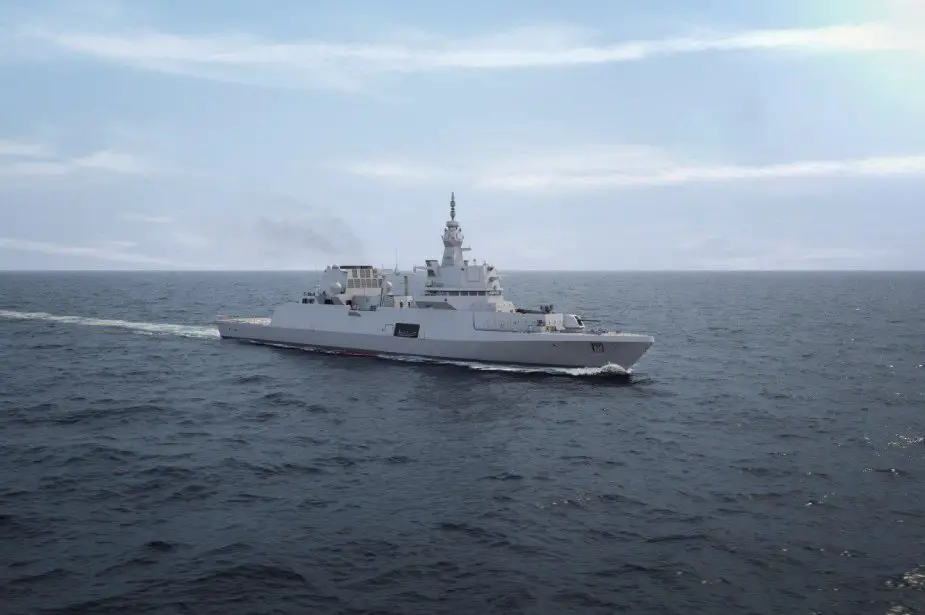To strengthen defense cooperation between Germany and Norway, the two countries have recently broadened their collaboration beyond the joint production of submarines to include the development of future naval projects, particularly the F127 air defense frigate. This expansion of their partnership underscores the strategic significance of Berlin and Oslo's relationship in the defense sector, especially within NATO.
Follow Navy Recognition on Google News at this link
 Artist overview of the F127 Frigate (Picture source:Thyssenkrupp Marine Systems )
Artist overview of the F127 Frigate (Picture source:Thyssenkrupp Marine Systems )
Last September, a contract worth 5.5 billion euros was awarded to ThyssenKrupp Marine Systems (TKMS) for the construction of six U212CD type submarines, divided between the German Navy and the Royal Norwegian Navy. This collaboration extends to crew training and exercise, as well as maintenance and armament, with a jointly developed combat system for the ships.
The cooperation does not end there, as it also encompasses the development of anti-ship missiles within the Super Sonic Strike Missile (3SM) Tyrfing program, led by Kongsberg. Norwegian Defense Minister Bjørn Arild Gram highlighted Germany as Norway's most important partner in Europe for defense equipment.
Boris Pistorius, Gram's German counterpart, expressed interest in further collaboration during a visit to Norway on March 7. He mentioned potential cooperation on the F127 frigate project, aimed at renewing the German Navy's fleet with six new units. Initiated in 2018 by the German Defense Ministry's planning department, the project initially aimed for cooperation with the Netherlands, although this collaboration appears to be facing challenges.
Norway plans to replace its "Fridtjof Nansen" class frigates with six new ships, potentially opening up for collaboration on the F127 program. According to Hartpunkt, the F127 frigates will be equipped with the American AEGIS system and designed to protect against a wide range of aerial threats while also having anti-submarine and anti-surface capabilities.
General Eirik Kristoffersen, chief of staff of the Norwegian Armed Forces, emphasized the importance of enhancing maritime patrol and anti-submarine warfare capabilities, highlighting the strategic interest of future frigates in this area. This focus on anti-submarine capabilities also explains Norway's interest in the Defense and Intervention Frigate (FDI) from France's Naval Group.
Other countries, including the Netherlands, had explored possibilities for cooperation with Germany on the F127 frigate project. The country wished to introduce new ships by 2032 to replace the De Zeven Provinciën class frigates. However, the states ended their collaboration after German Defense Minister Boris Pistorius decided in July 2023 to opt for an Aegis combat system solution for the German Next-Generation Frigate - Air Defense (NGFrig-AD, F127) program.
The proposed solution required the submission of a Foreign Military Sale (FMS) request, which would also apply to selling the frigates to Norway. The F127 project analysis began in 2021 and concluded in February 2023, allowing the program to move to the second phase or to develop options for the defense chief's review. The F127 was initially expected to replace the F124 class starting in 2032, but it now seems likely that this date will be pushed back a few years. Construction is not anticipated to begin before 2026.
The MEKO A400 Air and Missile Defence (AMD) frigate design from ThyssenKrupp Marine Systems was the preferred choice for the hull. With a length of 160 m, a width of 21 m, a depth of 5.5 m, and a displacement of 10,000 tons, the MEKO A400 AMD would be the size of a destroyer. It would be capable of a maximum speed of about 32 knots and have a range of over 4,000 km.



